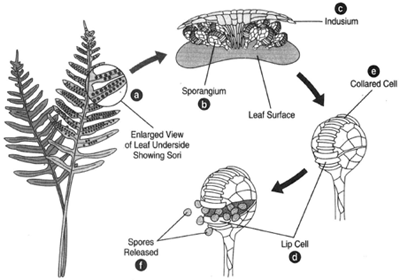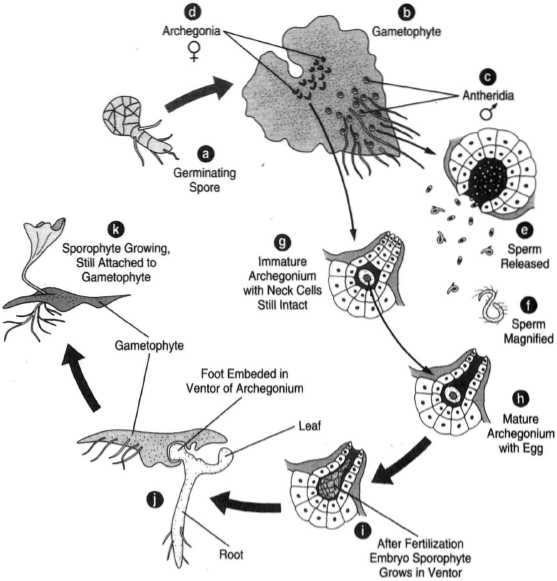Ferns
There are approximately 10,000 species of ferns. Ferns growin varied habitats. Marsilia, a rooted fern, grows in water. Salvinia floats on water. The woodland walking fern (Camptosorus) forms new plants wherever a leaf tip touches the soil; it thus can go (or grow) from one site to another. The shield fern (Dryopteris), maidenhair fern (Adiantum), adder’s tongue (Ophioglossum), and interrupted fern (Osmunda) are woodland species. The shoestring fern (Vinoria) is an epiphyte on tree trunks.The familiar leafy plant is the sporophyte. In many species of fern, the sporangia are found on the undersides of leaves. Sporangia occur in clusters called sori, and in many species, the sori are covered by a membrane called the indusium. In the sporangium, spore mother cells go through meiosis to produce meiospores. When
 |
| Figure 25-1 The sporophyte generation in the life cycle of a fern. (a) The underside of a small portion of fern leaf, showing sori. An enlarged drawinag of a sorus shows a sporangium, (b) and the indusium, (c) A lip cell, (d) and a collared cell, (e) in a yet to open sporangium. (f) The sporangium dehisces at thleip cells. (g) Spores are released |
the time comes for the spores to be released, the indusium becomes dry and splits. The sporangia open to release the spores, which then grow into gametophytes. The sporangium has a collar of cells with thickened walls, which tend to straighten and bend as the humidity changes. The sporangium dehisces where the lip cells are located.
The gametophyte is approximately one-quarter of an inch across. In some fern species, both antheridia and archegonia grow on the same thallus; in other species, the sexes are separate. When the plant is wet with rain or dew, multiflagellated sperm cells swim to the egg cell in the archegonium. Here, the new embryo sporophyte is briefly attached to and dependent on the gametophyte. Soon, however, a root penetrates the tissue of the gametophyte, and the sporophyte is established as an independent organism. Figure 25-2 shows that the first leaf of the young sporophyte is different from the leaves that come later.
 |
| Figure 25-2 The gametophyte generationin the life cycle of fern. (a)A spore germinates to produce the first few cells of the gametophyte. (b) The heart-shaped, mature gametophyte. (c) Antheridia among the rhizoids. (d) Archegonia near the notch of the upper portion of the gametophyte. (e) An antheridium opens to release sperm. (f) A much magnified spem cell, showing many cilia. (g) An immature archegonium with the neck canal cells still intact. (h) A mature archegonium with an egg. (i). The embryo sporophyte growining the venter of the archegonium. (j) The young sporophyte sends a root downward and a shoot upward with the primordium its first leaf. (k) The sporophyte continuess, till attached to the gametophyte. |




